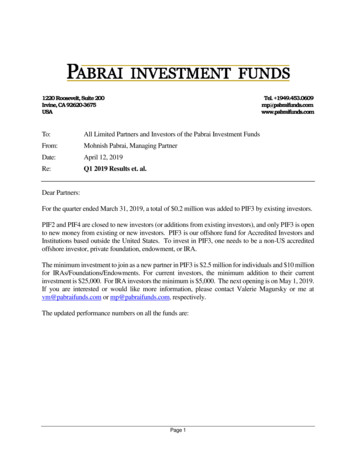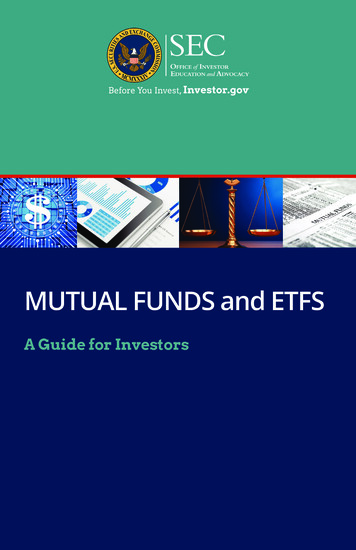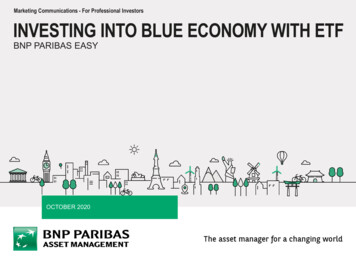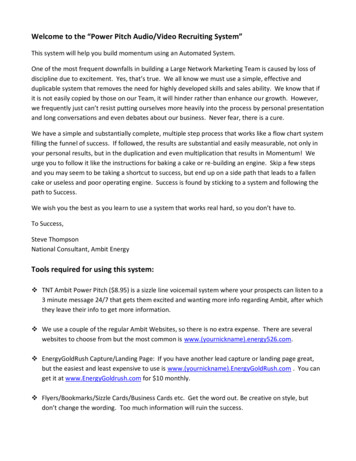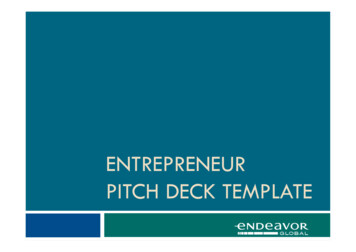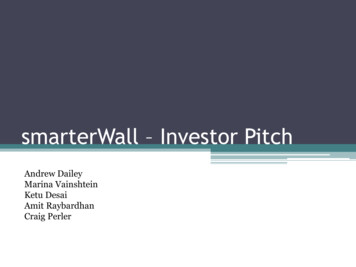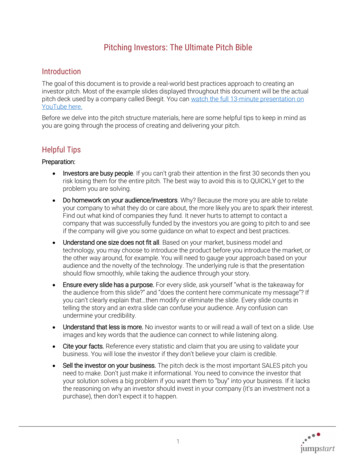
Transcription
Pitching Investors: The Ultimate Pitch BibleIntroductionThe goal of this document is to provide a real-world best practices approach to creating aninvestor pitch. Most of the example slides displayed throughout this document will be the actualpitch deck used by a company called Beegit. You can watch the full 13-minute presentation onYouTube here.Before we delve into the pitch structure materials, here are some helpful tips to keep in mind asyou are going through the process of creating and delivering your pitch.Helpful TipsPreparation: Investors are busy people. If you can’t grab their attention in the first 30 seconds then yourisk losing them for the entire pitch. The best way to avoid this is to QUICKLY get to theproblem you are solving. Do homework on your audience/investors. Why? Because the more you are able to relateyour company to what they do or care about, the more likely you are to spark their interest.Find out what kind of companies they fund. It never hurts to attempt to contact acompany that was successfully funded by the investors you are going to pitch to and seeif the company will give you some guidance on what to expect and best practices. Understand one size does not fit all. Based on your market, business model andtechnology, you may choose to introduce the product before you introduce the market, orthe other way around, for example. You will need to gauge your approach based on youraudience and the novelty of the technology. The underlying rule is that the presentationshould flow smoothly, while taking the audience through your story. Ensure every slide has a purpose. For every slide, ask yourself “what is the takeaway forthe audience from this slide?” and “does the content here communicate my message”? Ifyou can’t clearly explain that then modify or eliminate the slide. Every slide counts intelling the story and an extra slide can confuse your audience. Any confusion canundermine your credibility. Understand that less is more. No investor wants to or will read a wall of text on a slide. Useimages and key words that the audience can connect to while listening along. Cite your facts. Reference every statistic and claim that you are using to validate yourbusiness. You will lose the investor if they don’t believe your claim is credible. Sell the investor on your business. The pitch deck is the most important SALES pitch youneed to make. Don’t just make it informational. You need to convince the investor thatyour solution solves a big problem if you want them to “buy” into your business. If it lacksthe reasoning on why an investor should invest in your company (it’s an investment not apurchase), then don’t expect it to happen.1
Stress the ROI. For an investor to invest in your business, you have to make it very clearhow they will generate returns on their investment, not how great you think your productreally is. You have a great opportunity for the investor if he/she believes that they willmake significant returns on their investment, otherwise why would you expect someoneto invest? A savvy investor will always be focused on how much funding you will need toraise to be successful, how many different funding rounds you should expect to have overthe life of your company and how much dilution their investment will be subject to. Convey adaptability. Investors are looking for entrepreneurs who are willing to pivot astime goes on. Convey that you are ready to make necessary changes down the road ifneeded. Very rarely are founder’s initial pathways to success 100% accurate. For example,industry changes or regulations often cannot be predicted and are events that a founderwill have no control over or you might find a better use for your technology in anotherindustry. Don’t give them a reason to not invest. Investors are looking for a reason, any reason, notto invest. If there is anything in your message or slides that gives them pause, then theymay pass. At the end of the day, it’s smarter and safer to pass on an investment. Don’tgive them a reason. Investors are looking for low risk, high reward. Don’t dismiss it as a one-time-interaction. After the presentation, if you are not funded, takethe opportunity (if available) to hear the investors’ feedback. Find out what you could havedone differently and what they would want to see you improve on if you were going topitch to them again in the future. Don’t ever look at an investor pitch as a one-timeinteraction with no second chance. In some cases, companies have pitched to the sameinvestor several times before getting funded. Prepare in advance for funding. This Harvard Business School video titled Foundations ofFinancing and Capital Raising for Startups provides a straightforward overview of topicssuch as: preparing your company for the financing process, the different sources ofcapital, and legal and regulatory considerations. Learn from the experts. For expert tips on the pitch process, Here’s a Harvard BusinessSchool video on Getting Behind Your Pitch and another video presented by a VC titled “TheBest Pitch Decks: How to Create a Winning Pitch Deck” Review examples. Here are resources that provide pitch deck examples:oooPitch Deck Coach – sample pitch deck with commentsLinkedIn's Pitch – LinkedIn’s old pitch deck with commentsStartup Pitch Decks – website that shares many pitch examplesPitching: Tell a story that flows. Putting facts on slides is important, but it will not get your messageacross as well as having slides that consecutively build on the next. A good sanity check isto go through your deck and assign one key sentence for what each slide is trying to sayand see if the concepts connect. Pitch by analogy. Don’t be afraid to compare yourself to other, similar companies. Let the best presenter present. There is no shame in letting someone else from your teampresent if presentation skills are not your personal strength. There is no hard rule thatrequires the CEO to do the pitch. It’s certainly more commonplace for the CEO to present,2
but not absolutely required. The CEO needs to convey leadership; so one way ofdemonstrating that you can leverage the capabilities of your team is to empower them topresent. Don’t get defensive. Be prepared to take criticism without getting defensive, even if youthink the person you are pitching to is dead wrong. They may have experience you don’t ormay simply be trying to find holes in your story to see how you handle the situation. Theirmentality may be that they are also trying to figure out if they will be able to work with youthrough various issues that may arise. They don’t want to be stuck in a deal in whichadversity is just going to bring up conflict. Would you hire someone like that for yourcompany? Avoid investment ambiguity. In order to ensure the investor is even interested in yourcompany and that you meet the criteria necessary to receive their funding, do advanceresearch or ask them upfront to clarify their preferences for investment. One of thebiggest mistakes entrepreneurs make is not understanding right up front what an investoris looking for in an investment.Sharing Content: Format your pitch for sharing. Create your deck so it can easily be printed or understood ina PDF, which has no animation graphics. If your message requires build slides and otheranimations, create a separate deck that will be able to stand on its own when printed. Alsoexpect it will be shared and you don’t want people getting confused on static build slides. Don’t email the PowerPoint. Send your pitch in a PDF or you run the risk of having thedesign and formatting ruined upon transferring computers.3
Sample Pitch Deck with Supplemental Advice And ResourcesThis is the suggested flow (order) of slides for your presentation. As mentioned previously, feelfree to modify the order of your specific pitch deck if an alternative structure makes it flow better.Investor Pitch Deck Structure1.Company Purpose / Introduction .52.Problem .63.Solution / Product / Service .84.Traction. 105.Market Size/Opportunity . 126.Competition . 137.Go to Market Strategy . 158.Financials . 179.Team . 1910. Summary Slide . 2011. Appendix . 214
1. Company Purpose / Introduction Define the company in a single declarative sentence. See examples of introduction slidesat Pitch Envy. OR give your 30 second elevator pitch. Here’s a Harvard Business School video on TellingYour Story. Make sure that you clearly understand and can articulate your value proposition.Here’s a Harvard Business School video on Value Proposition.OR use a “power statement” to explain how your product is analogous to another situationthat proved to make a real difference. The statement should answer the question of “Whyshould I listen to you?”What to Do: This is your chance to begin to orient your audience with who you are, what you do, andhow you do it. Don’t get detailed, just scratch the surface. The opening slide should be clean and simple. Some say your opening slide should just have your company’s name, logo, and a singledeclarative statement with a more-or-less blank background. Others would say that alongwith your name, logo, and your declarative statement, you shouldn’t be afraid to include animage that helps describe what your company does. For example, if you are in the hotelbooking industry but your company’s name/logo doesn’t allude to this, you may want toinclude an image of a clean hotel room. Prepare a one-page tear-sheet to handout if helpful to support the presentation. Include your contact info on the opening slide.5
What Not to Do: Do not sell your product, but instead sell your company. Investors are not buying yourproduct, they are buying into your company/business. Do not cram too much information onto the slide. Simplicity and clarity are key. Avoid comparing yourself to market dominators like Amazon and Facebook. Thosecompanies are extremely unique through a combination of tech, smarts, funding and luck.Select companies that are closer to your business model, market and relevance.2. ProblemImagine that you are trying to convince someone that there is a real issue with something of greatconcern. You would build your argument by first making sure he/she understood the subjectmatter you are talking about and that they can relate to it. For example, let’s say you hate drinkingyour coffee when it gets cold. If you wanted to share your frustration with a colleague who didn’tdrink coffee, you would want to begin by saying to them “did you know that 90% of the countryonly likes to drink their coffee or tea when it is hot (according to a really reputable source)?” Nextyou would want to convey the pain hot beverage drinkers like yourself experience because youwant your coffee hot. For example, you might disclose that “X amount of money and X amounttime is wasted nationwide on constantly buying new hot coffee or making tons of trips to themicrowave to heat up coffee that has gone cold”. In the process you might even throw out somemore facts and figures and even tell a story about Joe “who added up his monthly trips toStarbucks because of this problem and found out that with the money he spent he could replace acar payment”. When positioning the problem, this is exactly what you are trying to do, but withyour own product/solution. Describe THE PROBLEM OR PAIN POINT your product or service will solve for withouttalking about your product. Someone has got to buy into the problem before they hearabout solving it (that will come next section, Solution/Product/Service). Define THE NEED (nice to have or need to have) – in the case of Beegit, companies needto work more efficiently as a team to create digital content (i.e. time savings & costsavings). Define THE PAIN – in the case of Beegit, it is difficult to manage team-produced digitalcontent due to communication and productivity gaps. Define THE STATUS QUO - how does the customer currently addresses the problem andthe extent to which the current solutions solve the problem.Customer discovery is a method used to deeply understand your potential customers’ needs andpain points, please click here for a guide on Customer Discovery.6
7
What to Do: Consider situations that will help you connect with the investors (assuming that is youraudience), which may involve doing a little research into their background. Assume thatthey don’t have the same background as you. Their understanding of the market problemmight be unclear. It is your job to not only make them understand, but also to make themexcited about it. Display ma
Pitching Investors: The Ultimate Pitch Bible Introduction The goal of this document is to provide a real-world best practices approach to creating an investor pitch. Most of the example slides displayed throughout this document will be the actual pitch deck used by a company called Beegit. You can watch the full 13-minute presentation onFile Size: 1MBPage Count: 21

